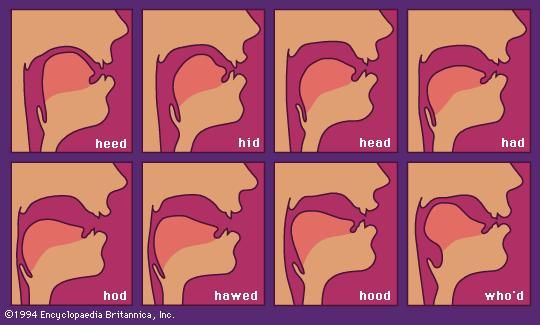Voicing is using different vowel shapes to improve intonation and response. These vowel shapes are created with your tongue in the same manner as when you speak. Voicing is the best way to change the intonation of notes without sacrificing the dynamic or tone quality. While it is easy to make a sound on the bassoon, playing with a full tone and accurate intonation in all registers requires voicing. Voicing includes the full continuum of vowel sounds from the lowest (“aah”) to highest (“eee”) and all possibilities in between. The two most extreme vowel positions bassoonists use are “aah” and “eee.”
“Aah” (as in the word “hot”, back of the tongue is low and oral cavity is fully open). When you have a sore throat, the doctor will ask you to stick out your tongue and say aah. Why do doctors choose this vowel? Because it puts the back of the tongue in its lowest position, resting against the floor of the mouth. This allows the doctor to see your throat. “Aah” is the lowest, most open vowel; the back of the tongue is relaxed against the floor of the mouth and the oral cavity is as open as possible. This vowel lowers the pitch and is the default position for most notes on the bassoon.
“Eee” (as in the word “see”, back of the tongue is high and space in oral cavity is small). This vowel places the back of the tongue near the roof of the mouth and decreases the space in the oral cavity. The sides of the tongue will touch the back teeth in this position. The “eee” vowel raises the pitch without negatively affecting the timbre of the notes.
The following chart includes the most problematic parts of the range and the suggested voicing. This chart is intended as a guide to the general pitch tendencies for most bassoons and players. The pitch tendencies for notes not included in the diagram are not as consistent from player to player and are more dependent on individual instruments, reeds, and players.
Experimentation will be needed to find the best voicing. You will need to adjust your voicing according to your own specific tendencies.

Tongue position and shape for eight common vowel sounds.

Encyclopædia Britannica, inc. (2024, March 6). Vowel. Encyclopædia Britannica. https://www.britannica.com/topic/vowel#/media/1/633094/3598
Say the word in each square and notice where your tongue is in your mouth. The difference between the syllables/shapes will be in the middle and back part of the tongue, not at the front or tip. This means you can still articulate notes with the front of your tongue while forming any of these shapes to change the intonation.

Feedback/Errata